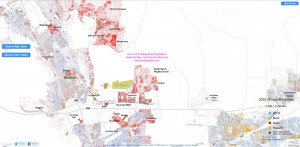 Wordings can be tricky – to put it simply, Vote No on Prop 16 if you do NOT stand for reservations (or Affirmative Action) in Public College Admissions (like the UC System), government jobs, or government contracts.
Wordings can be tricky – to put it simply, Vote No on Prop 16 if you do NOT stand for reservations (or Affirmative Action) in Public College Admissions (like the UC System), government jobs, or government contracts.
A “no” vote opposes this constitutional amendment, thereby keeping Proposition 209 (1996), which stated that the government and public institutions cannot discriminate against or grant preferential treatment to persons on the basis of race, sex, color, ethnicity, or national origin in public employment, public education, and public contracting.
Category Archives: Politics
Vote NO on Prop 16 is like Vote NO on Mandal Commission
 Wordings can be tricky – to put it simply, Vote No on Prop 16 if you do NOT want reservations in Public College Admissions (like the UC System), government jobs, or government contracts.
Wordings can be tricky – to put it simply, Vote No on Prop 16 if you do NOT want reservations in Public College Admissions (like the UC System), government jobs, or government contracts.
A “no” vote opposes this constitutional amendment, thereby keeping Proposition 209 (1996), which stated that the government and public institutions cannot discriminate against or grant preferential treatment to persons on the basis of race, sex, color, ethnicity, or national origin in public employment, public education, and public contracting.
Seeking South Asian Community Leaders in Pleasanton
My name is Harinder Grewal and I am a member of the Pleasanton Library Commission. The city of Pleasanton is considering building a new library as part of a new Civic Center off Bernal Avenue. One of our goals is to educate members of the Pleasanton Community on this plan.
As a commission member, my objective is to present this plan to all members of the Pleasanton Community, including those in South Asian organizations. If you are a member of a South Asian social/religious/community organization here in Pleasanton that would like to learn more about the new library plan, then please contact me at harinder6…@h…com.
Tri Valley Desi Population – on Map for the first time
What’s a better testimony than numbers? That the Tri Valley Area is undergoing a demographic transformation can be generally seen, but is clearly depicted in this Racial Dot Map produced by the Weldon Cooper Center for Public Service based on 2010 Census data. The RED dots represent Asian Population, and its easy to see how the area looked like almost four years back. If anything, the density of the red may only be increasing in this area; in fact rather drastically over last couple of years.
Granted the red dots represent the Asian population as a whole, not people from Indian sub-continent as such. But going by what one may be observing see on the streets, stores and schools, and anecdotal data, it may not be an over statement to say that the desi Indian population is almost exploding at least in some specific areas.
The Dot Map below from Cooper Center has been over laid with specific local areas/streets to help easily identify the areas under focus.

The Map provides a good picture of which Tri Valley Areas are popular with the Asians or Indians. What really comes as no surprise is the Windermere, Gale Ranch, Camino Tassajara area of San Ramon, along Bollinger Canyon Road. Its known to be thickly populated with Indians and Chinese. On some streets and roads you will only find Indian households door to door, one after the other. Some people says its much of a South Indian microcosm. The schools of the area present the same picture – and have excellent scores. Next in San Ramon are some older areas in west San Ramon along Alcosta and Marketplace. Particularly apartments there are high density Indians. Coming down south, the Pine Valley area has some desi population, and further south, the area between Alcosta and Village Parkway in Dublin is again heavily dotted with red.
East Dublin is the other major desi area. Especially the last couple of years has seen a major influx of desis moving from all over the Bay Area into the Dublin Ranch neighborhood, including Positano and other new construction going on in the area at fast pace that supposedly provides some of the best value in the entire Bay Area. The prime area surrounding popular Emerald Glen park is pretty multi racial, but still reasonably desi as well. Especially towards the north of it. Dublin Boulevard from Hacienda to Village Parkway provides the best desi shopping experience with multiple stores and the Regal Cinema at Hacienda is always on with the latest Hindi release from Bollywood. The schools in the area are getting better every year – that is a no brainer. The Brigadoon area on the far west has a few desis living as well, and so do the apartments along the Dougherty Road. The apartment/condo living next to Bart in Dublin again has a good concentration of desi folks.
Pleasanton is where this Dot Map helps to give a more definitive picture than is generally known. The area between Owens Drive, Avalon Apartments and Stoneridge is heavily red. This has probably even gone higher in last year – especially with the apartments in the area. As Stoneridge meanders to the east, the homes around it are again pretty Asian, going up drastically around the south western end of Stoneridge. While West Pleasanton over all has a sprinkling of Indian population, the central business district goes quite opposite, and then again increases along 680, and showing high around the apartments south of Stoneridge Mall.
Asians are generally sprinkled over all of Tri Valley area, and Livermore shows the same pattern. The Indian population shows a little higher numbers around the Livermore Temple, kind of expected.
Check for the actual numbers from the 2010 Census for Asian Indians in Tri Valley Area with Percentage.
If you are aware of specific areas that are significantly growing in Indian Desi population, please feel free to comment below.
Pleasanton, Dublin redistricting may result in Indian-American winning US Congress seat
Last week, Pleasanton, Dublin and Danville have been redistricted in the Congressional electoral map. And this suddenly creates a possibility that we may see the third ever Indian-American getting elected to the U.S House after Dalip Singh Saund (1956)and Bobby Jindal (2004).
So what’s the scoop, and who are we talking about here?
A young Indian-American is now challenging established norms in an audacious bid to win a seat in the U.S House of Representatives. Ranjit Gill, a law student at University of California in Berkeley is just 24 (he’d have crossed the qualifying age by election day), but he’s drummed up a war chest of nearly $ 500,000, the third-highest in the country for a Republican challenger, forcing the party leadership and political pundits to take notice. If Gill can pull it off, he will be the youngest U.S Congressman since 1797.

Gill, known locally by his nickname Ricky, is aiming for the Ninth Congressional District in California, which is currently held by Democrat Jerry McNerney, 60, an engineer from Pleasanton now serving his third term. Normally, few would have given the Indian-American upstart any chance, considering the monotonous regularity with which incumbents, riding on the odds stacked against challengers in terms of raising money and nursing constituency, are re-elected.
But a growing anti-incumbency mood coupled with lucky breaks in constituency redistricting offers Gill a sniffing chance. An electoral map approved this week by California’s bipartisan Citizens Redistricting Commission will include more of San Joaquin County, where Hispanics outnumber whites, while cities like Pleasanton and Dublin (McNerney strongholds) have been moved to other districts. Local pundits say the changes have dropped areas that Gill knows nothing about (read Dublin, Pleasanton) and constituents who know nothing about him. McNerney has already said he would move from Pleasanton to San Joaquin County.
A first generation Indian-American whose parents are both physicians, Gill is pumped up in an area which has a large Sikh community involved in farming and agriculture and a big Hispanic labor force. His forbears hail from Ropar in Punjab but he was born in a town called Lodi, California (not related to the dynasty or the town from the sub-continent; it’s a town most famous for Zinfandel wine) and speaks both Punjabi and Spanish. Gill has staked out positions on major issues for the agricultural industry, including his support for diverting water to the San Joaquin Valley and the creation of a guest worker program.
Much of his campaign contributions are believed to come from alumni supporters at Princeton and UC Berkeley, and Indian-Americans in the medical, agricultural, and academic fraternity. California’s large and pedigreed Sikh community and the nearly 15 per cent Asian-American population in the district has already lined up to support him. His parents, both obstetricians who moved to the area in the 1970s, are well known in the medical community and are plugged into a sprawling fund-raising network for local political causes, which Gill has tapped into from his campaign headquarters at the Flag City RV Resort near Lodi.
Gill will turn 25 — the minimum age required to be a member of the House — a month before the June 2012 primary. He was 17 when Gov. Arnold Schwarzenegger chose him to serve as the student member of the State Board of Education. He attended Princeton University, graduating in 2009 with a bachelor’s degree in public policy.
So Dublin, Pleasanton, Danville residents don’t really get to vote for Ranjit Gill. But the fact that voters in these cities are not part of his contituency now simply increase his chances of winning.